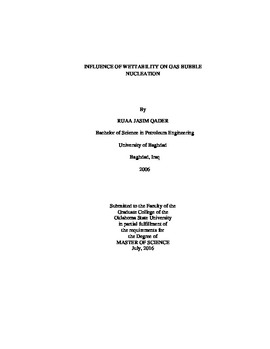| dc.description.abstract | Gas bubble nucleation and liberation from supersaturated liquid solutions takes place in a wide range of natural and industrial processes, such as volcanic eruption, cloud formation, production of carbonated drinks, manufacturing of polymers, electrochemical processes, and petroleum production and refinery systems. Bubble nucleation from a liquid system is the first step of gas liberation process. Usually, the bubble nucleation begins on vessel and/or solid particles (if any) surfaces.The aim of this research was to experimentally study the effect of wettability on gas bubble nucleation. An experimental facility that can provide high levels of supersaturation and control pressure during step-down process was designed and built. The design of the research depends on providing a continuous source of CO2 (gas phase), which can be pressurized and transferred into a pressure cell that contains a glass vial filled with water (liquid phase) to a specified height. Hydrophilic and hydrophobic vials and glass beads were used for the bubble nucleation experiments. Chlorinated polydimethylsiloxane (CM) and chlorinated fluoroalkylmethylsiloxane (CF) coatings were implemented on the glass vials and beads to obtain hydrophobic surfaces. A pulseless pressure of CO2 was supplied by utilizing a microfluidic P-Pump that could provide a pressure range of 0-10 bar to the vial in the pressure cell. Semi-infinite diffusion equation for planar geometry was used to estimate the time required for CO2 to reach the equilibrium concentration. 6000 mbar pressure for 24 hour saturation time was applied to the pressure cell to saturate CO2 in 5 mm height of water in a 10 mm ID glass vial. 1000, 500 and 100 mbar step-down pressures were used to initiate pressure-driven bubble nucleation process. A digital microscope was used to record high quality pictures and videos of the bubble nucleation process. All the experiments were performed at room temperature 25 �C (77 �F). Contact angle, atomic force microscopy (AFM) and X-ray photoelectron spectroscopy (XPS) measurements were conducted for the treated and untreated glass substrates for wettability, surface roughness, and surface chemistry, respectively.Hydrophilic vials did not cause bubble nucleation even when the pressure was reduced to atmospheric pressure. However, both the CM and CF coated hydrophobic vials resulted bubble nucleation during the pressure releasing process. The results of using hydrophilic and hydrophobic glass beads inside hydrophilic vial confirmed the effect of wettability on gas bubble nucleation. So, it can be concluded that wettability alteration of the solid surfaces using coating techniques can enhance the rate of pressure-driven bubble nucleation. | |
